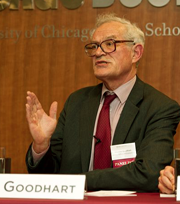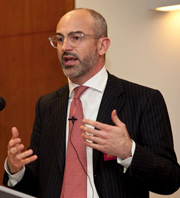March 12, 2012
Experts from the public and private sector in Britain joined economists from University of Chicago for a lively panel discussion in London that explored the interplay between financial markets and the macroeconomy.
The event, held at the University of Chicago Booth School of Business Europe Campus, drew an audience of more than 150 alumni and guests from the business community. University Trustee Sekhar Bahadur, Lab’77, AB’81, MBA’83, Vice Chairman at Deutsche Bank, was on hand to open the event.
Against a backdrop of dire fiscal realities in Europe, the discussion began with fiscal policy.  John Cochrane
John Cochrane, AQR Capital Management Distinguished Service Professor of Finance at Chicago Booth, focused on the long-term U.S. debt picture. He shared Congressional Budget Office projections showing that the ratio of publicly-held federal debt to gross domestic product is heading for 100 percent. That is unsustainable, he said.
John Cochrane
John Cochrane, AQR Capital Management Distinguished Service Professor of Finance at Chicago Booth, focused on the long-term U.S. debt picture. He shared Congressional Budget Office projections showing that the ratio of publicly-held federal debt to gross domestic product is heading for 100 percent. That is unsustainable, he said.
“In the good old days, you could have a 5 percent interest rate, 4 percent growth and that 1 percent surplus could support 100 percent debt-to-GDP,” he noted. During the recession, very low interest rates offset low growth rates, which helped. “What keeps me awake at night is that we can't have near-zero interest rates forever,” he said. "The problem is, in the U.S. we have -10 percent surpluses, and that seems like it's going to last forever. Then we have 5 percent interest and -10 percent surpluses and then you're in big trouble.
“We need growth. Not a quarter’s growth, or last month’s good job numbers, or even a year or two of stimulus, but year-in, year-out growth―thee kind of growth that comes with productivity, innovation, and people and goes on forever.”
Cochrane explored the three policy options commonly considered: austerity, stimulus, and growth.
“Austerity, as we're experiencing in Greece, is not working,” Cochrane said, noting that the real danger is an austerity spiral, where higher taxes lower growth. Likewise, stimulus spending cannot boost the economy nearly enough to climb out of debt. “The problem is, where do we get the money. The multiplier would have to be six to make it self-financing, and nobody believes that’s true.” To inflate the debt away would require doubling the price level—a disaster, he added.
The answer is pro-growth policies, he concluded. “The economy is a garden; it needs weeding and fertilizer. It's time to weed the garden and get rid of all the little protections and regulations. Weeding is hard. We’ve had a lot of manure, what needsto happen now is some serious weeding.”
 Charles GoodhartCharles Goodhart, Professor of Banking and Finance at the London School of Economics, said that the debt picture is not quite as grim as Cochrane painted it. Historically, Great Britain has fought its way out of worse debt- to-GDP ratios three times. “The problem is, however, in some sense worse for some EU countries, as John mentioned, because if you don’t have some plan for some kind of austerity, for getting debt down in the future, the markets are going to take flight,” he said, adding, “The problem in U.S. is a political problem, not an economic problem.”
Charles GoodhartCharles Goodhart, Professor of Banking and Finance at the London School of Economics, said that the debt picture is not quite as grim as Cochrane painted it. Historically, Great Britain has fought its way out of worse debt- to-GDP ratios three times. “The problem is, however, in some sense worse for some EU countries, as John mentioned, because if you don’t have some plan for some kind of austerity, for getting debt down in the future, the markets are going to take flight,” he said, adding, “The problem in U.S. is a political problem, not an economic problem.”
The third panelist, Francesco Garzarelli, Managing Director and Co-Head of European Macro Research with Goldman Sachs in London, saw no reason why economies would go back to the growth levels seen before the crash. Without that kind of growth, “the dynamics are going to look pretty lousy,” he noted. “We're going to have a period of time where the markets won't give banks or governments the benefit of doubt.”
He added that the neutralization of public debt seen in cases like Greece and Spain can’t continue. “Th dquo;too big to fail” problem without distorting the forces of market discipline, diminishing incentives for creative and productive activity, or encouraging excessive risk-taking.
Goodhart pointed out that regulation is, unfortunately, procyclical. “Whenever you have a crisis, regulators say, ‘That must never happen again.’ They shove on every regulation they can. As time goes on, we then see the losses and costs of regulations, so they naturally get eroded, and the crisis occurs where regulations have eroded away.”
As a former monetary adviser to the Bank of England, he personally has seen and survived three financial crises, all related to simple, basic banking. “Regulating behavior won't work, regulating structure won't work. I think we have to go back to incentives to managers,” he said. He called for restricting bankers' pay when their companies fall into a lower performance tier judged to be at high risk for takeover or collapse, but noted that such a scheme is unlikely to be implemented.
Cochrane pointed out that the regulatory response to the financial crisis is causing some odd contradictions in the U.S. “We're in this strange place in the US where the fed is trying to shove money down the system, while another part of the government is saying, ”Don't you dare lend money to anyone.’ It’s a crazy situation, with 3 percent mortgages nobody can actually get.”
 Francesco GarzarelliStandard risk analysis assumes that macroeconomic uncertainty is priced into securities markets. Hansen asked Garzarelli how the recent financial crisis alters how we think about the sources and levels of uncertainty, and the implications for bond and equity markets in the Euro area.
Francesco GarzarelliStandard risk analysis assumes that macroeconomic uncertainty is priced into securities markets. Hansen asked Garzarelli how the recent financial crisis alters how we think about the sources and levels of uncertainty, and the implications for bond and equity markets in the Euro area.
Garzarelli said uncertainty is stemming from unprecedented events. He called the financial crisis of 2008–09 “cardiac arrest” and “a big outlier” outside of the experience and trading history of most people.
“The August–November 2011 EMU ‘breakup’ conjecture also represents an extra-institutional event,” he added. “Nobody's sure what that looks like; we got a lot of calls from hedge fund managers looking for guidance there.”
He showed a chart mapping a shift in risk across the EU, moving from an intricate network of cross-border claims with more than half of Italian and Spanish bonds in the hands of foreign investors, to a very risky hub-and-and spoke configuration with the ECB at the center, warehousing this debt. Although this removes some uncertainty by mitigating liquidity risk and counterparty exposure, other sources of ambiguity still need to be tackled, he said.
Sponsors
We gratefully acknowledge the CME Group Foundation for generous support of this event.
